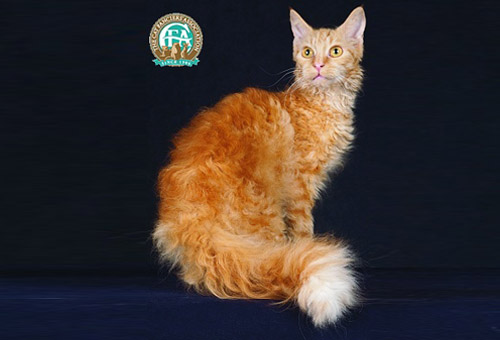

 |
GC, BW KLOSHE BC PHOENIX OF DENNIGAN, Red Tabby Longhair LaPerm Female Photo: © Chanan |
 Pictured: Second Best of Breed GC TRIPLE TIARA AMAGI, Tortoiseshell Longhair LaPerm Female Photo: © Satoshi Daichi The LaPerm comes in every recognized color and coat pattern. Some kittens can be born hairless, but most have short wavy hair or straight hair at birth. Kittens often go almost totally bald beginning with a spot on the tops of their heads. This process generally starts when the kittens are about two weeks old and they can be in varying stages of baldness during their first four months or so. The coat will generally come back in and will always be curly if the kitten was born curly. Coat variations throughout the life of a LaPerm range from molting that can leave a sparse, thin coat for life to a possible full coat after neutering or spaying. LaPerms are gentle and affectionate but also very active. Unlike many active breeds, the LaPerm is also quite content to be a lap cat. The LaPerm will often follow your lead, that is if they are busy playing and you decide to sit and relax, simply pick up your LaPerm and sit down with it and it will stay on your lap devouring the attention you give it. LaPerms seek human contact and will purr as soon as they become aware of your presence. They are inquisitive by nature and always want to know what is going on around them. They will reach for your face with their paws and rub their faces against your head, neck and face.  Pictured: Third Best of Breed CH QWERLIE LANDMAR OF BLUE AMBER, Blue Lynx Point & White Longhair LaPerm Male Photo: © Satoshi Daichi LaPerms are truly different from any other breed of cat because of their unique combination of appearance and people oriented personalities. The breed has captivated nearly everyone who has the opportunity of seeing one. Once a LaPerm graces your household you will be hard pressed to think of living with any other breed and may find it a necessity to have more than one. Cradling a LaPerm in your arms can touch your senses. Running your fingers through the sensuous coat becomes automatic and you won't want to stop. Listening to the purr and seeing the intelligence unfold as you teach your cat tricks such as fetching will give you an unmatched feeling of love and respect for the breed. Pricing on LaPerms usually depends on type, applicable markings and bloodlines distinguished by Grand Champion (GC), National Regional winning parentage (NW or RW) or of Distinguished Merit parentage (DM). The DM title is achieved by the dam (mother) having produced five CFA grand champion/premier (alter) or DM offspring, or sire (father) having produced fifteen CFA grand champion/premier or DM offspring. Usually breeders make kittens available between twelve and sixteen weeks of age. After twelve weeks, kittens have had their basic inoculations and developed the physical and social stability needed for a new environment, showing, or being transported by air. Keeping such a rare treasure indoors, neutering or spaying and providing acceptable surfaces (e.g. scratching posts) for the natural behavior of scratching (CFA disapproves of declawing or tendonectomy surgery) are essential elements for maintaining a healthy, long and joyful life. There are CFA clubs devoted to the promotion, protection and preservation of the LaPerm breed. For more information, please send inquiries to CFA at cfa@cfa.org. Text: A.D. Lawrence Last Updated: Tuesday, May 18, 2010
|